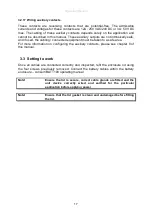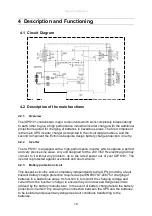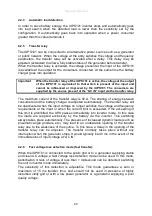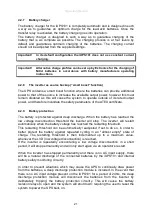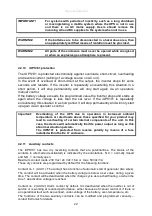
Operating Manual
20
4.2.4
Automatic load detection
In order to save battery energy, the IUPS101 inverter stops and automatically goes
into load search when the detected load is lower than the sensitivity set by the
configuration. It automatically goes back into operation when a power consumer
greater than this value demands it.
4.2.5
Transfer relay
The IUPS101 can be connected to an alternative power source such as a generator
or public network. When the voltage at the entry satisfies the voltage and frequency
parameters, the transfer relay will be activated after a delay. This delay may be
adjusted (extended) to allow a fully stable status of the generator before transfer.
When the transfer relay is activated, the voltage present at the input of the iUPS101
is available at the output for the consumers connected. At the same time the battery
charger goes into operation.
Important When the transfer relay of the iUPS101 is active, the voltage at the output
of the IUPS101 is equivalent to that which is present at the input and
cannot be influenced or improved by the iUPS101. The consumers are
supplied by the source present at the “AC IN” input via the transfer relay.
The maximum current of the transfer relay is 50 A. The sharing of energy between
consumers and the battery charger is adjusted automatically. The transfer relay will
be deactivated when the input voltage no longer satisfies the voltage and frequency
requirements at the input or when the current limit is exceeded. If the exceeding of
this limit is prohibited, the UPS passes immediately into inverter mode. In this case
the loads are supplied exclusively by the battery via the inverter. This switching
always takes place automatically. The presence of increased dynamic loads (such as
pneumatic angle grinders, etc.) may lead to an undesirable opening of the transfer
relay due to the weakness of the source. To this case, a delay in the opening of the
transfer relay can be adjusted. The transfer normally takes place without any
interruption when the generator stops. It would typically be 40 ms in the event of the
immediate loss of input voltage at “AC IN”.
4.2.6
Fast voltage loss detection mode (fast transfer):
When the iUPS101 is connected to the public grid or to a generator supplying stable
and clean AC voltage, a fast voltage loss detection mode can be used. In this mode,
perturbation or lack of voltage of less than 1 millisecond can be detected, switching
the unit in inverter mode immediately.
The sensitivity of this detection is adjustable. This mode guarantees a zero or
maximum of 15 ms transfer time, and should not be used in presence of highly
disturbed utility grid or with a low power generator or a generator supplying a poor
quality voltage.
Содержание iUPS101
Страница 1: ...Installation Operating Manual iUPS101...
Страница 55: ...Operating Manual 55...
Страница 59: ...Operating Manual 59 11 5System Assembly Details...
Страница 62: ...Operating Manual 62 14 Certification 14 1Atex Label...
Страница 63: ...Operating Manual 63 14 2Atex Certificate...
Страница 64: ...Operating Manual 64...
Страница 65: ...Operating Manual 65...
Страница 66: ...Operating Manual 66...
Страница 67: ...Operating Manual 67...
Страница 68: ...Operating Manual 68 14 3iUPS101 EC Declaration of Conformity...
Страница 69: ...Operating Manual 69 14 4UPS System EC Declaration of Conformity...












